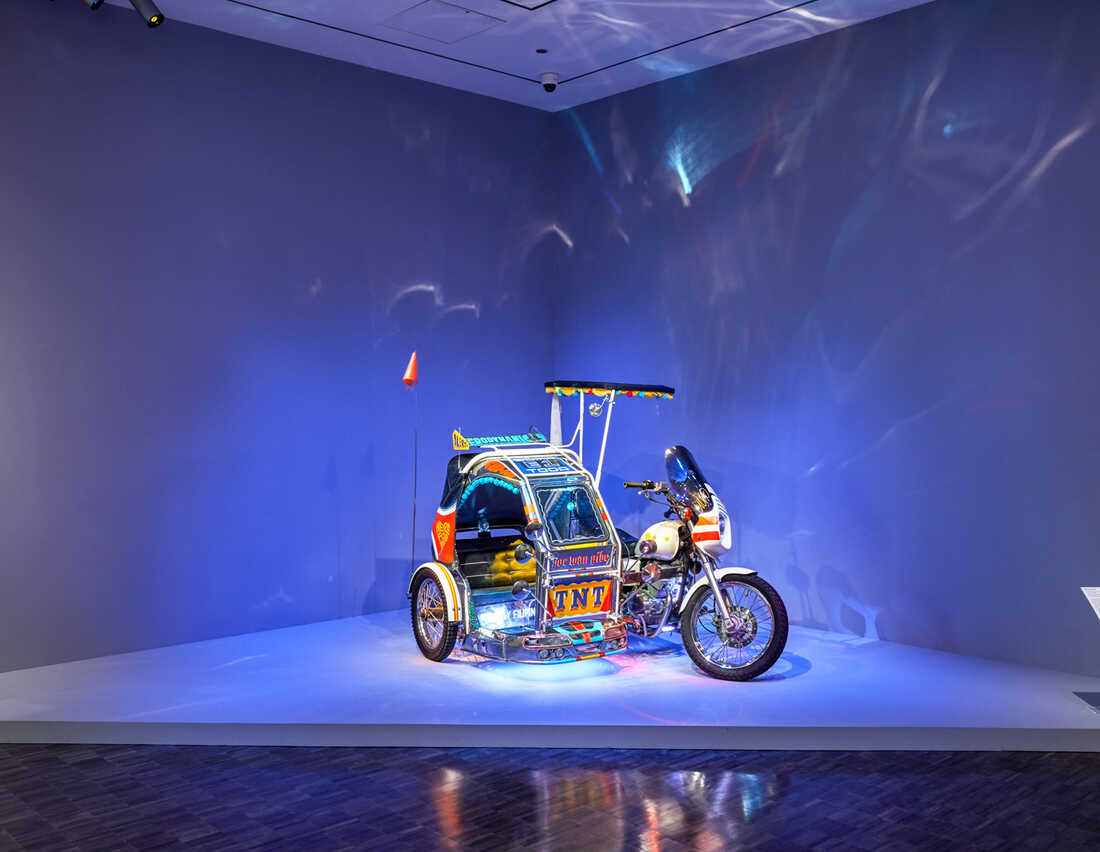How one Filipino American artist influenced the work of a generation of others

Portrait of Carlos Villa in his studio, 1985.
Patricia Arian/Asian Art Museum, San Francisco
hide caption
toggle caption
Patricia Arian/Asian Art Museum, San Francisco

Portrait of Carlos Villa in his studio, 1985.
Patricia Arian/Asian Art Museum, San Francisco
In 1958, when the late Filipino American artist Carlos Villa was studying at the California School of Fine Arts, he asked one of his teachers where he could learn about other Filipino art.
“His teacher said to him there isn’t any,” said Mark Johnson, co-curator of Carlos Villa: Worlds in Collision, a retrospective of Villa’s work at the Asian Art Museum of San Francisco.
That response inspired Villa to go beyond his own art, and make it his mission to help other artists of color.
“His whole career was trying to focus on filling in that story both for himself and for artists in the future,” said Johnson.
Villa died in 2013, but his legacy continues. As a professor at the San Francisco Art Institute for four decades and a powerful community organizer and mentor, Villa had an outsize impact on dozens of younger artists. His students included Obama portraitist Kehinde Wiley and Mission School art pioneer Barry McGee.
Villa devoted his career to uplifting others, but now he is getting his due as an artist in his own right: The exhibition at the Asian Art Museum is the first in the country to give a Filipino American artist a major retrospective.
It includes the artist’s paintings and installations, many of which explore multiculturalism, decolonization and Filipino identity, like his resplendent feathered capes, evoking both the vestments of Villa’s Catholic youth in San Francisco and robes worn by the Hawaiian aristocracy. A companion exhibition at the San Francisco Arts Commission features his later works, and an earlier iteration, which included both shows, closed at the Newark Museum of Art in May.

One of Carlos Villa’s feathered capes, on view in the exhibition.
Kevin Candland/Asian Art Museum, San Francisco
hide caption
toggle caption
Kevin Candland/Asian Art Museum, San Francisco
The Asian Art Museum show also features pieces by his protégés. For example, a vintage motorcycle and side-car — a typical way Filipinos get around — tricked-out with sparkly lights, bright pom-poms and a karaoke machine, created by two former students, Filipino Americans Michael Arcega and Paolo Asuncion.
Sometimes the motorcycle tools around the Bay Area. But behind the fun is a serious political message about making space for Filipino American voices. “We want to signal that we are around and present,” Arcega said.
Arcega said this use of art as literally a vehicle for increasing Filipino visibility was inspired by Villa, who thought street life should be an inspiration for art.

The “TNT Traysikel” — a tricked-out motorcycle side-car installation by artists Paulo Asuncion and Michael Arcega on display at the Asian Art Museum
Kevin Candland/Asian Art Museum, San Francisco
hide caption
toggle caption
Kevin Candland/Asian Art Museum, San Francisco
“I came into visual arts through graffiti art and have kind of carried that pride because of Carlos to this project,” Arcega said.
New York-based Filipino American artist Paul Pfeiffer also studied with Villa. He said his mentor worked to increase the visibility of artists of color in the white-dominated art world by organizing a slew of landmark conferences starting in the 1970s.
Those conferences changed his life. “It felt like the first time that I was seeing a kind of conversation about art and art history that felt like it included me,” Pfeiffer said.
Today, Pfeiffer is an internationally-recognized political artist with work in the collection of New York’s Guggenheim Museum.
His video installation in the exhibit shows a boxing match in which one of the contenders — prize-fighter-turned-politician Manny Pacquiao — faces off against an opponent whose presence on screen has been erased by the artist. The piece explores the Filipino body under assault, fighting invisible forces.
Pfeiffer said Villa helped to shape his political awakening. “He opened the door,” Pfeiffer said. “He clued me into it.”

The Mail Order Brides’ installation at the Asian Art Museum, ‘Chatsilog Revisited.’
Kevin Candland/Asian Art Museum, San Francisco
hide caption
toggle caption
Kevin Candland/Asian Art Museum, San Francisco
Reanne Estrada, an artist in Los Angeles, said another of Villa’s superpowers was bringing young artists together. “He exposed me to a different way of thinking about how to be an artist,” Estrada said. “How you connect with other people.”
Estrada is part of the surrealist art collective Mail Order Brides. She said the Brides came into being nearly 30 years ago when Villa introduced her to fellow Filipina Americans Eliza Barrios and Jenifer Wofford.
The Brides’ multimedia installation in the exhibition playfully pays tribute to their mentor. Villa’s face beams from a video screen, as footage on nearby screens shows Estrada, Barrios and Wofford bumbling around a kitchen making the traditional Filipino breakfast dish silog.
“Even after decades of working together, we’re still a bunch of slightly wacky ladies wearing granny panties and egg aprons,” Estrada said. “Carlos would be proud to know some things don’t change.”
For all the latest Entertainment News Click Here
For the latest news and updates, follow us on Google News.
